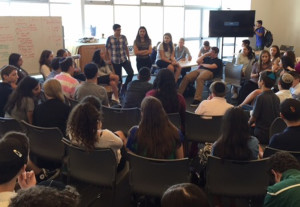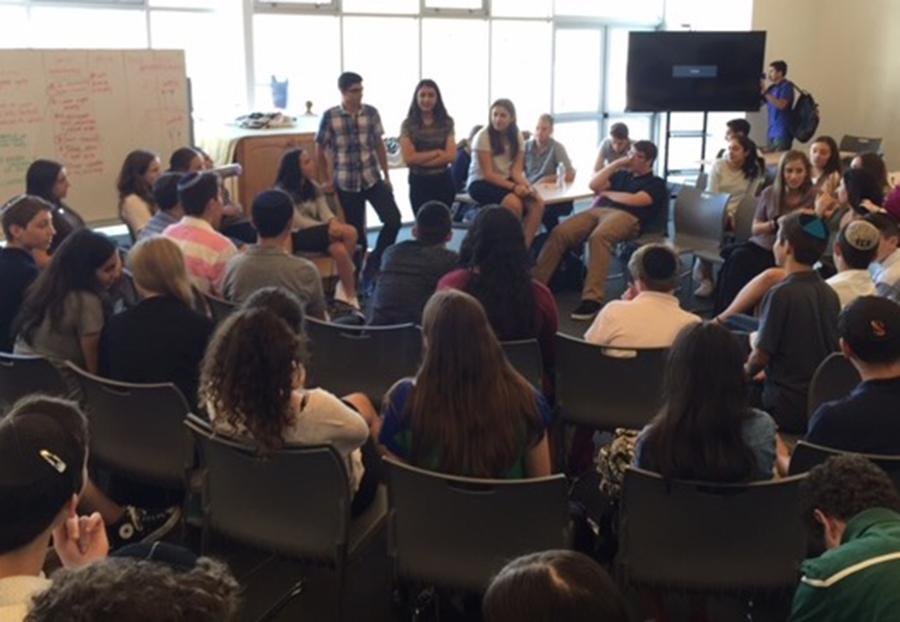Ten hours in 10 days devoted to reinvigorating the Just Community
November 9, 2015

SKILLS: Led by seniors Eric Bazak, Shirel Benji and Laly Chriki, students meeting in the Beit Midrash considered school problems using various techniques and moral perspectives.
Common good. Community. Proposals. Parallel thinking.
These words bounced off the new Shalhevet walls during the first two weeks of school, as 10 hours of class time were devoted to learning about and analyzing one of Shalhevet’s most unusual characteristics: the Just Community.
Students missed one period — and once, two periods – of class per day as student leaders and teachers taught everyone new skills and vocabulary, along with Lawrence Kohlberg’s stages of moral development.
“Like anything you’re doing that’s important,” said Head of School Rabbi Ari Segal, “you need to revisit it, strengthen it, and evaluate if it’s working in the way it is supposed to.”
Interviews suggested that upperclassmen didn’t enjoy it as much as freshman and sophomores did. But everyone — including teachers, who were eager to get their classes going — agreed that the Just Community was in need of a tune-up.
“It’s been fascinating,” said freshman Clara Sandler. “I really now understand what the Just Community that I’ve been hearing about is. “
It was the latest in a string of Just Community reorientations that the school has held over the years, though scheduled differently. Divided into seven sections that met in various places around the school, they learned how to resolve problems like the lack of student initiative to clean up after meals by using specific methods of brainstorming and group processing.
By the first Town Hall Sept. 11, students had come up with five specific proposals to deal with actual controversies facing the school: dress code and davening policies.
For the 10 meetings, school was divided into seven groups, each led by students and teachers and meeting in a designated location, either the cafeteria, gym, Beit Knesset, Beit Midrash, Wildfire Theater, theater stage, or the art room.
The first sessions were about Kohlberg’s stages of moral development, which teach that the simplest motivation for doing something is to avoid punishment, while the highest level of decision-making is thinking of how the decision will affect the “common good” of the community.
In a workshop on parallel thinking, students learned to break down problem-solving into concrete stages represented by different colored hats. The “green hat” stage, for example, involves brainstorming solutions to a given problem, while the black hat stage is for critiquing possible ideas.
Groups then applied the decision-making skills to policy issues in the school.
“It was very Socratic,” said freshman Ayala Chocron. “Everyone was able to give their own points and no one had to be worried about holding anything back.”
Some proposals from the reorientation are already in effect. Others, Agenda chair Micah Gill said at the first Town Hall, will undergo an experimental period in the coming weeks.
At the first Town Hall, a week and a half into school, Micah opened the floor for feedback on the reorientation and presented the new proposals regarding dress code and tefillah.
The dress code proposals included forming a dress code committee and creating a system in which a number of students are assigned other students to watch and make sure they are in dress code. (See related story).
Tefillah proposals included having a cell phone basket in each minyan, with student volunteers enforcing the use of the baskets and allowing students to read books about davening if they felt trouble connecting directly with prayer.
However, these two policies were only adopted in the main minyan.
The cell phone basket is only used when Dean of Students Mr. Jason Feld is at the minyan, said sophomore Michelle Greenberg, a regular attendee of the main minyan. But she said that even when Mr. Feld is not there, the students are careful not to go on their phones.
When the series was over, upperclassmen described the meetings with words like “useless” and “boring,” but they participated fully nonetheless.
“For the seniors, I don’t know if it was that helpful,” said senior Derek Orenshein. “But the seniors’ being there had an impact on the freshman. We gave them ideas; we helped them realize what the Just Community was about. Even though it wasn’t helping us, we were helping them.” .
A number of freshmen said the process gave them a fresh understanding of what the Just Community is. But some were confused at first.
“Even though we’ve done this so many times, I still don’t really know what the Just Community is,” said freshman Noah Altman.
That sparked disagreement within his group until senior Laly Chriki, one of the leaders, clarified what the sessions were all about.
“What we’re trying to do is answer Noah’s question,” Laly said. “We’re talking a lot about the common good, but now that’s what you’re thinking about. You need to be reminded about it so many times to actually be thinking about it.”
Most teachers were initially frustrated that one or more of their classes would be missed for the programming, but eventually they saw its value. Ms. Tove Sunshine, who has five history and social science classes this year, thought the extra work was worth it.
“It was incredibly stressful,” said Ms. Sunshine. “I was teaching a double load because I was teaching those sessions. But I felt it was getting off on a foot that made clear what our values are.”
New General Studies Principal Mr. Daniel Weslow said he understood.
“As much as that first week was grueling for students and faculty because it’s a new school year and we were taking time out of classes,” said Mr. Weslow said, “it was powerful in the sense that everyone was engaged in some capacity.
“This process was vital to ensuring that everybody had a shared language regarding and around the Just Community.”
The last time something was done in a similar light was in 2009, when the school was divided up into groups led by seniors and two full days were devoted to discussing the Just Community.
“I think it’s perfect timing that they’re doing this now,” said music teacher Mrs. Joelle Keene, who has been at Shalhevet since 2004, “but it’s not the first time. It seems to me that the school just needs to be reinvigorated once in a while.”
When founding Head of School Dr. Jerry Friedman – a student of Lawrence Kohlberg — was in charge, all new faculty had to come in a week earlier than the rest of the faculty to have a week of Just Community training, Mrs. Keene said.
There are no plans to do anything as intense as the reorientation again this year, but Mr. Weslow said there would probably be “checkups” throughout the year, and in future years, to ensure that this is not a “one-and-done thing.”
“We all get busy but one of the things that we need to remember to do is an inventory on how things are progressing,” Mr. Weslow said.
The reorientation was planned over the summer with Dr. Steve Bailey, a researcher, author, and consultant in Jewish Education who co-founded Shalhevet with Dr. Friedman.
Dr. Bailey led a weeklong Just Community training for faculty and staff. Using many concepts and techniques he introduced, Judaic Studies teacher Rabbi Ari Schwarzberg and Dean of Students Mr. Jason Feld took lead in preparing the curriculum for the programs.
